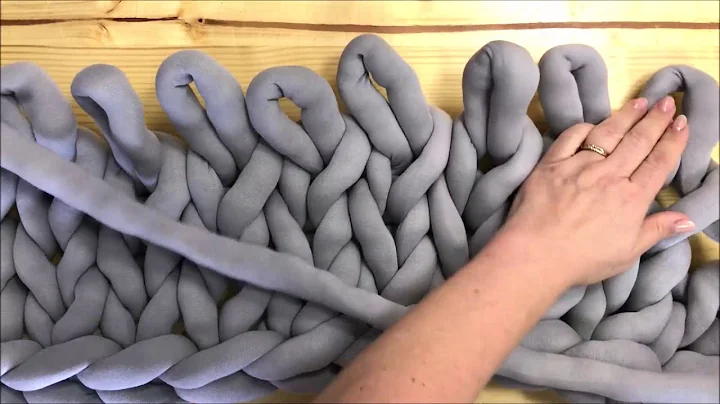The Perfect Number of Granny Squares for Your Blanket
Table of Contents
- Introduction
- Determining the Size of a Regular-Sized Blanket
- 2.1. Understanding the Different Blanket Sizes
- 2.2. Choosing the Size of Your Blanket
- 2.3. Measuring Your Granny Squares
- 2.4. Calculating the Number of Granny Squares Needed
- 2.5. Accounting for Borders and Stretch
- Conclusion
Determining the Size of a Regular-Sized Blanket
When it comes to crocheting a blanket, one of the most common questions is, "How big do I have to make my granny squares, and how many do I need to create a regular-sized blanket?" The answer to this question depends on a variety of factors, including the desired blanket size and the size of each granny square. In this article, we will break down the elements involved in determining the size of a regular-sized blanket and guide you through the process step by step.
2.1. Understanding the Different Blanket Sizes
Before we can determine the size of your granny squares, it's important to understand the different sizes of regular blankets. The size of a blanket can vary depending on its purpose. It could be a throw blanket for cuddling up on the couch, a baby blanket, or a larger-sized blanket for a twin, double, queen, or king bed. Here are the average dimensions for each type of blanket:
- Throw Blanket: Varies, commonly around 50-60 inches wide and 60-70 inches long.
- Baby Blanket: Typically around 30-36 inches wide and 36-52 inches long.
- Twin Blanket: Approximately 66 inches wide and 90 inches long.
- Double/Full Blanket: Around 80 inches wide and 90 inches long.
- Queen Blanket: Approximately 90 inches wide and 90-100 inches long.
- King Blanket: Usually around 108 inches wide and 90-100 inches long.
By determining the size of the blanket you want to make, you will have a better idea of how many granny squares you will need to crochet.
2.2. Choosing the Size of Your Blanket
Once you have decided on the size of the blanket you want to make, it's time to choose the size of your granny squares. There are no strict rules when it comes to the size of granny squares. The best advice is to make the granny square that you like. You can make it with five rows, three rows, or four rows, and use whichever colors you prefer. Experiment and create granny squares that appeal to your personal taste.
2.3. Measuring Your Granny Squares
After you have crocheted your preferred granny square, it's important to measure its dimensions. To do this, lay your completed granny square in front of you and grab a measuring tape. Measure the square from one corner to the opposite corner to determine its size. For example, if the measurement is six inches, write it down as "Granny Square = 6 inches squared."
2.4. Calculating the Number of Granny Squares Needed
Once you have measured your granny square, it's time to calculate the number of squares you will need to create your desired blanket size. Start by writing down the dimensions of the blanket you have chosen. For example, if you want to make a blanket that is 60 inches by 80 inches, write down "Short Side = 60 inches" and "Long Side = 80 inches."
To determine the number of granny squares needed for the short side, divide the measurement of the short side by the size of your granny square. For instance, in our example, divide 60 inches by 6 inches, resulting in 10 granny squares needed. Repeat the same process for the long side, dividing 80 inches by 6 inches, which gives you 13 granny squares needed.
Remember that you may need to consider fractional numbers when dividing the dimensions by the size of the granny square. Round down or up to the nearest whole number, depending on your preference.
2.5. Accounting for Borders and Stretch
When determining the number of granny squares needed, it's important to remember that you will likely add a border to your blanket. The border will contribute a couple of extra inches to the overall size of the blanket. Therefore, if you are unsure whether to err on the side of too many squares or too few, it is generally better to err on the side of a few squares too few.
The reason for this is that when you join all your squares together, there will be a slight stretch due to the weight of the blanket. The stretch will give your blanket a little more length and width. Additionally, when you add the border, it will further increase the dimensions of the blanket across the top, bottom, and sides. As a result, even though your blanket may not measure exactly 60 inches by 80 inches, it will be close to that size.
If you are making a blanket specifically to cover a bed, you can consider going slightly longer to ensure it reaches from floor to floor. However, in most cases, blankets are folded up or folded in half and draped across the edge of a bed. Ensure that the length is sufficient for someone to get underneath and stay warm.
Conclusion
Determining the size of a regular-sized blanket requires careful consideration of various factors such as the desired blanket size, the size of each granny square, accounting for stretch and borders. By following the steps outlined in this article, you can calculate the number of granny squares needed to create your perfect blanket. Remember to choose the size of the blanket first, measure your granny squares, and divide the dimensions accordingly. With these guidelines in mind, you'll be able to create a beautifully crocheted and perfectly sized blanket for any occasion.
 WHY YOU SHOULD CHOOSE BEAUTYBADY
WHY YOU SHOULD CHOOSE BEAUTYBADY







